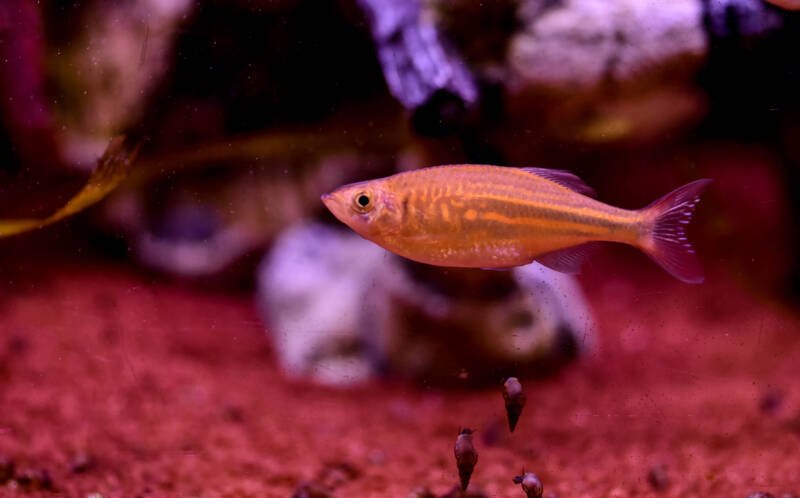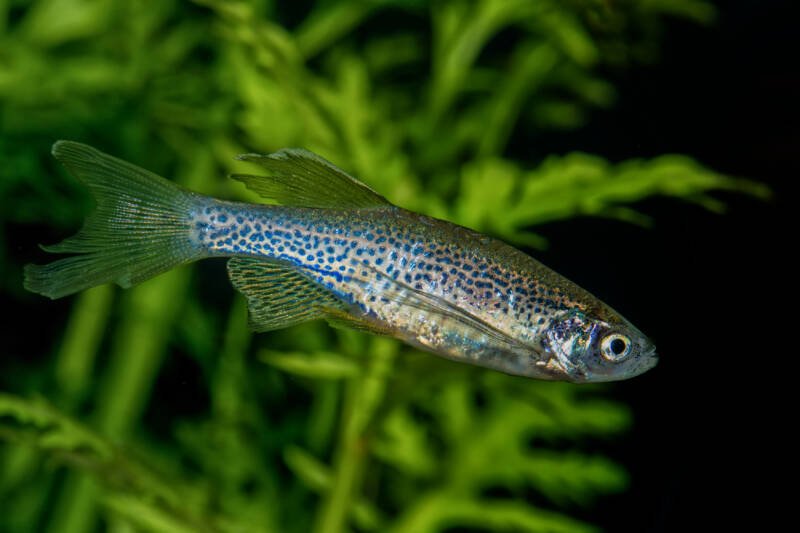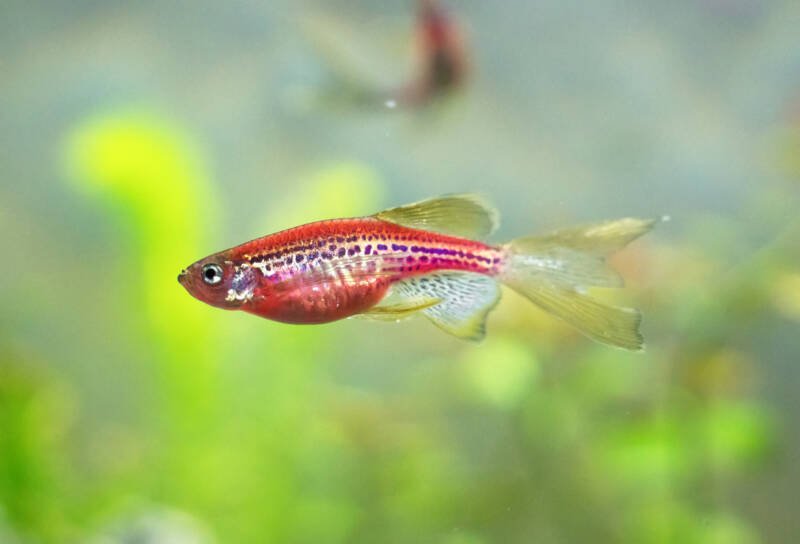What is the appeal of the zebra danio? Simplicity.

This breed is simple to care for, hardy and tolerant, peaceful and playful.
Perhaps best of all, they are simple to breed; and that is great news for those new to aquarium keeping who may want to breed their fish for the first time.
In this article
Zebra Danio Biology

The zebra danio (Danio rerio) is a beautifully striped, small-sized fish that is extremely popular in the aquarium trade.
This sleek, streamlined freshwater fish hails from India and sports vibrant colors in purple, blue, gold, and silver hues.
They live for up to five years and have a very active nature, adding visual interest and movement to the middle and upper levels of a community tank.
In their natural habitat, they live in a wide range of environments; thus, they are adaptable and can tolerate various water conditions in captivity.
Do danios give live birth?

No, the zebra danio is an egg-laying species. When we say “pregnant,” we mean “with eggs and ready to spawn.”
In the wild, this species spawns during the monsoon season, when the increase in rainfall results in a change in the water temperature. More on how that relates to breeding them in captivity below.
Are zebra danios easy to breed?
Yes, this species is very easy to breed in captivity. One important note is that zebra danios form bonded pairs and choose a lifetime mate. This bond is strong enough that even if one of the pair dies, the other may not mate again.
For captive breeding, you will have better odds if you start with a group of zebra danios and let them pair up naturally.
Can zebra and leopard danios breed?

Yes, because they are the same species. The leopard danio is a spotted variation of the zebra.

They both share the same Danio rerio name and can therefore breed.
Differences between Male and Female Danios
Step one of breeding your fish is to know which are male or female. Differentiating between the sexes of zebra danios is difficult as both have virtually the same features.
The female may be slightly larger and wider than the male, which may appear slender and torpedo-shaped.
Males can occasionally have a golden hue to their background color, while females are more silver.
Set Up a Breeding Tank
This species is small, reaching an adult length of 2 inches (5 cm), so you will not need a very large tank in which to breed them.
A five or 10-gallon tank is sufficient for breeding your fish and raising the young fry.
Decorations
Start by lining the tank with coarse gravel and fill it to a depth of about six inches with water.
Add a few leafy plants, such as young java fern, in the shallow water. If you keep your tank’s water temperature on the warmer side, you can consider adding the Amazon sword plant, which is easy to care for.
These plants will not only help with the water conditions, but their leaves will provide shelter for the developing fry.
Water Parameters
Zebra danios prefer water temperatures in the range of 64 to 74 degrees Fahrenheit (18 to 24 degrees C).
The pH should be between 6.5 and 7.5 and the water hardness between 5 to 12 dGH.
Water upkeep is always important, but even more so if you plan to breed your fish. Although the zebra danio has a high tolerance for varied water conditions, poor water quality can stress your fish and make them more susceptible to disease.
You do not want your breeding fish to develop common freshwater tank ailments, such as ich or dropsy or the bacterial infection mycobacteriosis.
Equipment
Equipment requirements for breeding zebra danios are minimal.
To keep the water clean, install a sponge filter or a below gravel filter. These provide cleaning power without the danger of sucking in any of the tiny newborn fry.
Consider investing in some water testing kits to ensure your water conditions are optimal. Regular testing will help you maintain the health of your parent fish and fry.
Feeding Your Mating Pair
Separate your male and female danios for one to two weeks and condition them with high protein foods. These omnivores love brine shrimp, mosquito larvae, and bloodworms.
Feed them twice per day and only as much as they can consume within two minutes.
Remember that large amounts of uneaten food will decay and impact your water quality.
How to tell if your zebra danio is carrying eggs?

Over this one-to-two-week conditioning period, the danio eggs will develop in the female.
So, what does a zebra danio look like when pregnant? She will appear noticeably swollen and rounded in the belly.
Spawning
At this time, you can place your bonded pairs in the breeding tank and gradually raise the water temperature so that it is close to 78 degrees Fahrenheit (26 degrees C).
Done just prior to dawn, this should trigger spawning.
How long do zebra danios lay their eggs?
If your female zebra danio is carrying eggs and has been placed with her bonded mate, she will typically lay the eggs within 24 hours.
Where do zebra danios lay eggs?
The female danio will scatter anywhere from 300 to 400 eggs on the gravel substrate.
Using coarse gravel will allow the danio eggs to be protected from being eaten by the adults as the eggs can slip between the gravel pieces.
How can you tell if a zebra danio egg is fertilized?
A fertilized egg will appear translucent, while unfertilized eggs are white.
Do zebra danios eat their babies?
Yes. This species will eat their own eggs if given the chance. They will also readily snack on the newly hatched fry.
Remove the parents from the breeding tank after the eggs are laid to avoid this occurrence!
Hatching
Wait for two to three days for the eggs to hatch. The newborn fry will be very small and transparent.
Because they are so difficult to see, take care when doing water changes to avoid scooping them up.
Baby Zebra Danio Care and Feeding
For the first few days, the tiny fry will stay with and get all their nutrients from their egg sacs.
Once they become free swimming, you can feed them infusoria or powdered commercial fry food. Pick foods that are formulated for egg-laying fish species.
As the fry continue to grow, you can transition them to baby brine shrimp or flake food.
Once the fry have grown large enough to not be eaten by other fish in the community tank, you can begin to introduce them.
Closing Thoughts
You will find that the zebra danio is one of the easiest species to care for and breed in an aquarium setting.
With minimal requirements for tank setup, a high tolerance for varied water conditions, and easy care of the fry, this species is truly an excellent choice for someone new to breeding fish.
Drop us a message in the comments below. We would love to hear about your experiences breeding zebra danios.
What advice would you give to a first-time breeder?